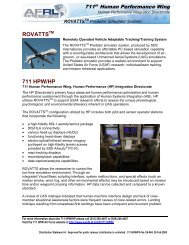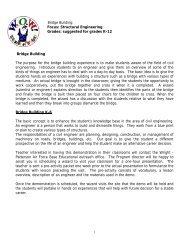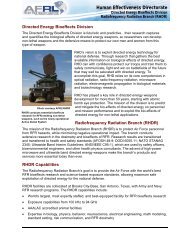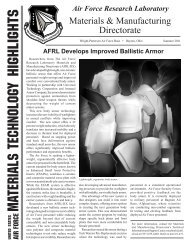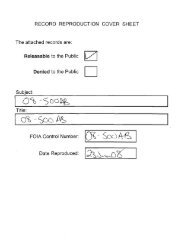TO 00-20-14 30 SEPTEMBER 2011 - Wright-Patterson Air Force Base
TO 00-20-14 30 SEPTEMBER 2011 - Wright-Patterson Air Force Base
TO 00-20-14 30 SEPTEMBER 2011 - Wright-Patterson Air Force Base
- No tags were found...
You also want an ePaper? Increase the reach of your titles
YUMPU automatically turns print PDFs into web optimized ePapers that Google loves.
<strong>30</strong> September <strong>20</strong>11 <strong>TO</strong> <strong>00</strong>-<strong>20</strong>-<strong>14</strong>3.8 CARE OF TMDE.Activities owning and using TMDE are responsible for its proper handling, transportation to and from designated drop offpoints, care, use and cleanliness. These are important factors in ensuring that TMDE performs reliably within specifiedtolerances for the duration of the established calibration interval.3.8.1 Physical characteristics of TMDE. Physical characteristics of TMDE range from sturdy to fragile. The sturdy canbe outer cases with shock suppression mountings. The fragile can be components that can be damaged by a slight jolt,scratch or static electricity. Special handling instructions for specific items are prescribed in maintenance <strong>TO</strong>s whenhandling requirements exceed normal practice. Electrostatic Discharge (ESD) control procedures are described in MIL-HDBK-263B Electrostatic Discharge Control Handbook for Protection of Electrical and Electronic Parts, Assemblies,and Equipment, MIL-STD-1686C, Electrostatic Discharge Control Program for Protection of Electrical and ElectronicParts, Assemblies, and Equipment, and <strong>TO</strong> <strong>00</strong>-25-234.3.8.1.1 Items of TMDE shall be handled as "delicate instruments" regardless of outer physical appearance.3.8.1.2 TMDE that is too heavy or awkward to be carried by one person may require team lifting or mechanicalassistance (AFOSHSTD 91-501, <strong>Air</strong> <strong>Force</strong> Consolidated Occupational Safety Standard).3.8.1.3 Items of TMDE shall be handled individually unless the item's size and physical characteristics allow it to beheld in one hand.3.8.1.4 External cords, cables, accessories and special connectors shall be secured to the case before movement.3.8.1.5 All unmated connectors shall be kept covered with moisture-proof and vapor-proof caps. Exceptions are whenstored in environmentally controlled areas or if subject to use on a daily basis. Unmated connectors on units that containcircuitry susceptible to ESD damage shall be covered with conductive caps (Reference <strong>TO</strong> <strong>00</strong>-25-234, paragraph7.5d(12)(d)). Do not substitute the use of tape for the caps.3.8.1.6 Metal-to-metal contact with TMDE items shall be avoided unless the total instrument is contained in a protectivecase.3.8.1.7 Only TMDE awaiting work, in delay status or delivery to the customer shall be stored in the PMEL receivingand shipping areas. If a portion of the area is used for other purpose(s), the area shall be well marked as to status orpurpose of use.3.8.1.8 All TMDE shall be stored on shelves or racks unless the physical characteristics prevent this type storage. Itemsof TMDE constructed so that the instrument is completely contained in a case may be stored on metal or wooden shelvingwithout further protection. Care must be taken to protect protruding dials, knobs, or meter faces. TMDE not constructedin cases shall be protected from damage by use of suitable containers and appropriate padding. Containers, protectivecaps and coverings, and padding are not required for equipment in work or subject to use on a daily basis. Items ofTMDE completely contained in packing cases may be stored on the floor.3.8.1.9 TMDE shall be removed from service if it has been subjected to overloading, mishandling, gives suspect results,or otherwise determined to be defective. Properly tag and store the TMDE to prevent further use until it can be scheduledfor repair or calibration.3.8.2 Transportation of TMDE. Transportation of TMDE by trained personnel using a regularly assigned and speciallyconfigured vehicle will provide the maximum degree of protection to the equipment. Physical characteristics ofindividual TMDE shall dictate the extent of protection required during transportation. In general, protection from theelements and excessive shock and vibration is all that is required for TMDE in a protective case. Padding protectionbetween items on the same vehicle may be required to protect knobs, dials, and meter faces from damage if the loadshifts.3.8.3 Cleaning TMDE. The user shall clean the exterior of all TMDE immediately before transporting to the PMEL.TMDE may be returned to the user for cleaning. When an item is disassembled in the calibration area of the PMEL andfound to be dirty internally, the calibrating technician shall return the item to the cleaning room. Dust removal may bedone in the calibration area by vacuuming only. Use ESD approved systems when vacuuming ESD sensitive internal3-17




